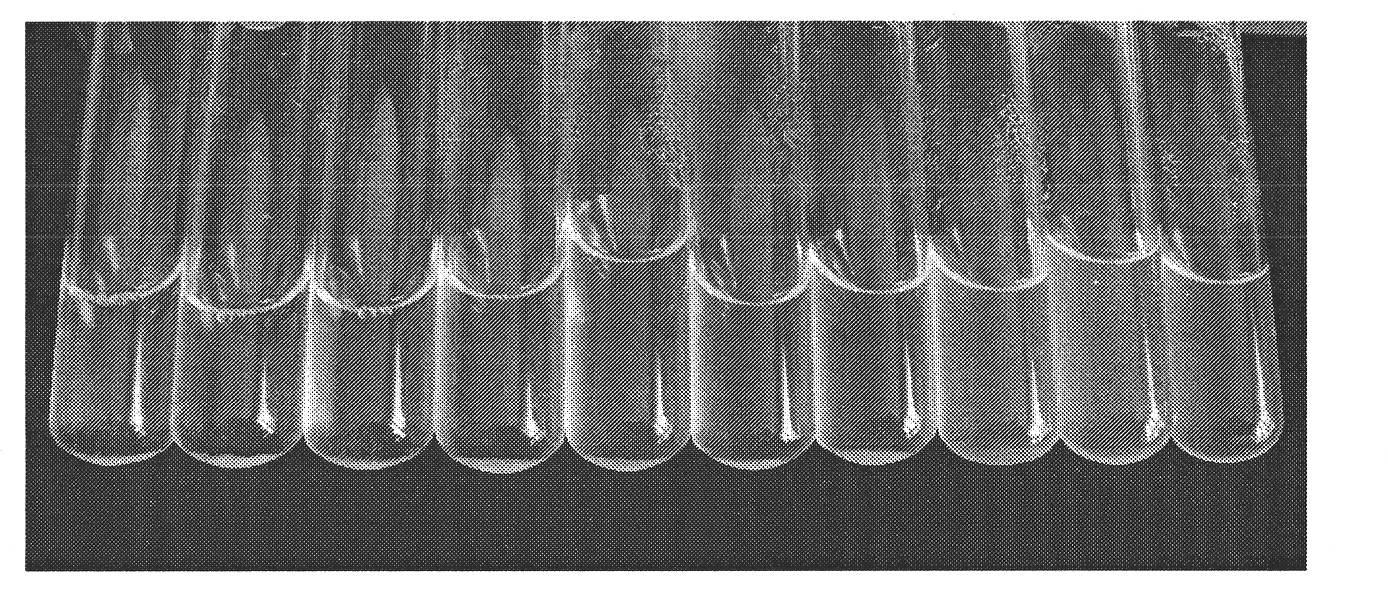Method for quickly detecting pathogenic bacteria carried by plant seeds of bacterial black rot
A detection method, plant seed technology, applied in the determination/inspection of microorganisms, biochemical equipment and methods, bacteria, etc., can solve the problems of false negative PCR reaction and small reaction system, achieve high sensitivity, overcome limitations, improve Effects of Sensitivity and Reliability
- Summary
- Abstract
- Description
- Claims
- Application Information
AI Technical Summary
Problems solved by technology
Method used
Image
Examples
Embodiment 1 10
[0056] Example 1. Obtaining antiserum against Bacterial black spot of cruciferous vegetables
[0057] Refer to the methods in "Veterinary Microbiology and Immunology Technology" and "Plant Disease Research Methods" for the preparation of bacterial cell (de-flagella) antigen, preparation of bacterial whole protein antigen, immunization of rabbits, determination of serum titer and antibody Specificity (test tube agglutination method, indirect ELISA method), indirect ELISA method to determine the accuracy of antigen detection.
[0058] (1) Preparation of bacterial cell (de-flagella) antigen
[0059] The Pseudomonas syringae spotted pathogenic species (3935 in Table 1) cultivated for 48 hours was prepared with normal saline (isotonic saline 0.85%) to a final concentration of 3×10 8 ~3×10 9 CFU / ml bacterial suspension, boiled at 100℃ for 1h.
[0060] (2) Preparation of bacterial whole protein antigen
[0061] The Pseudomonas syringae spotted pathogenic species (3935 in Table 1) cultivated f...
Embodiment 2
[0078] Example 2. Routine PCR detection of bacterial black spot in cruciferous vegetables
[0079] Use bacterial genomic DNA extraction kit to extract chromosomal DNA of all target and non-target bacteria (Table 1 and Table 2), see Figure 4 , 1-8 is part of the chromosomal DNA of the bacteria.
[0080] Table 1 Test bacterial black spot (target) strains
[0081]
[0082] Table 2 Tested non-target strains
[0083]
[0084]
[0085]
[0086] Step 1 Use DNAssist 2.0 to compare the 16S-23S rDNA ITS of each subspecies of Pseudomonas syringae, and use Primer Premier 5.0 and Oligo 6.0 software to design the primers to obtain the specific primers (SEQ ID NO1):
[0087] Forward primer T1: 5’TGCTTTGCACACCCGATTT 3’
[0088] Reverse primer T2: 5’CCCCAAGCAATCTAGGT 3’
[0089] Step 2 Perform specific detection on the designed specific primers of bacterial black spot, using the chromosomal DNA of the target bacteria in Table 1 and the non-target bacteria in Table 2 as templates, using Promega's Taq DNA ...
Embodiment 3
[0091] Example 3. Detection of bacterial black spot pathogen in cruciferous vegetables by immunoadsorption PCR (IMS-PCR)
[0092] Solution preparation:
[0093] Saturated ammonium sulfate solution (SAS): in 990ml H 2 Add 1.219g Tris to O, adjust pH to 7.0, and dilute the final volume to 1L to prepare 0.01mol / L Tris·Cl solution. Weigh 767g(NH 4 ) 2 SO 4 , Stir and heat slightly to dissolve it in 1L 0.01mol / LTris·Cl, adjust the pH to 7.0, and store at 4°C. When stored at 4℃, the bottom of the bottle should be visible (NH 4 ) 2 SO 4 Crystal.
[0094] 33% (v / v) SAS solution: 33ml SAS solution plus 67ml PBS, adjust the pH to 7.0.
[0095] PBS(pH7.4): NaCl 8.10g, NaH 2 PO 4 0.18g, Na 2 HPO 4 1.97g, 1L distilled water, autoclaved at 121°C for 20min, stored at room temperature.
[0096] Immunomagnetic beads (IMBs): Dynabeads M-280 Sheep anti-Rabbit IgG (Dynal, 2ml / bottle).
[0097] PBS-BSA: PBS contains 0.1% bovine serum albumin.
[0098] Step 1. Antiserum purification.
[0099] Under constant s...
PUM
 Login to View More
Login to View More Abstract
Description
Claims
Application Information
 Login to View More
Login to View More - R&D
- Intellectual Property
- Life Sciences
- Materials
- Tech Scout
- Unparalleled Data Quality
- Higher Quality Content
- 60% Fewer Hallucinations
Browse by: Latest US Patents, China's latest patents, Technical Efficacy Thesaurus, Application Domain, Technology Topic, Popular Technical Reports.
© 2025 PatSnap. All rights reserved.Legal|Privacy policy|Modern Slavery Act Transparency Statement|Sitemap|About US| Contact US: help@patsnap.com



